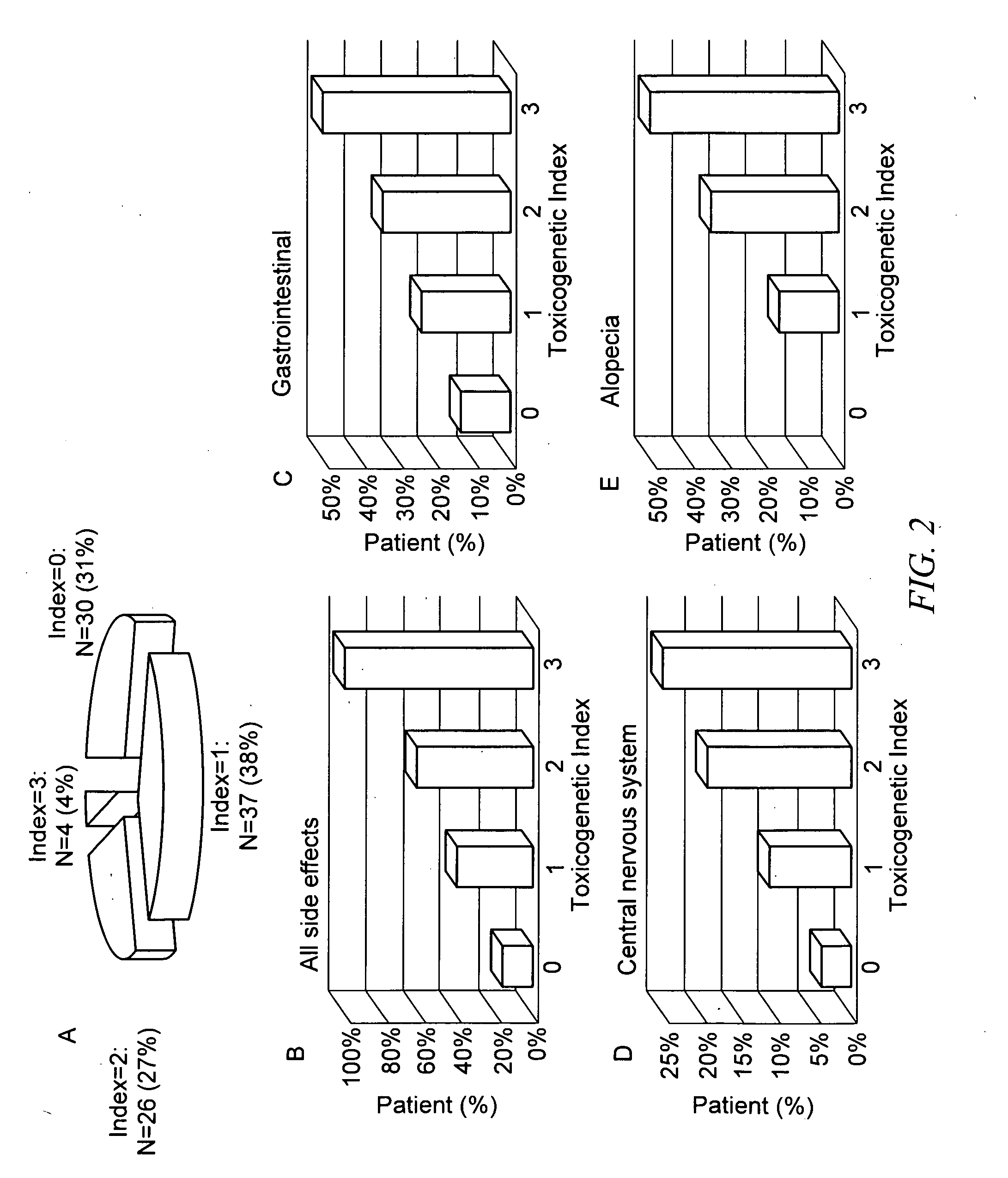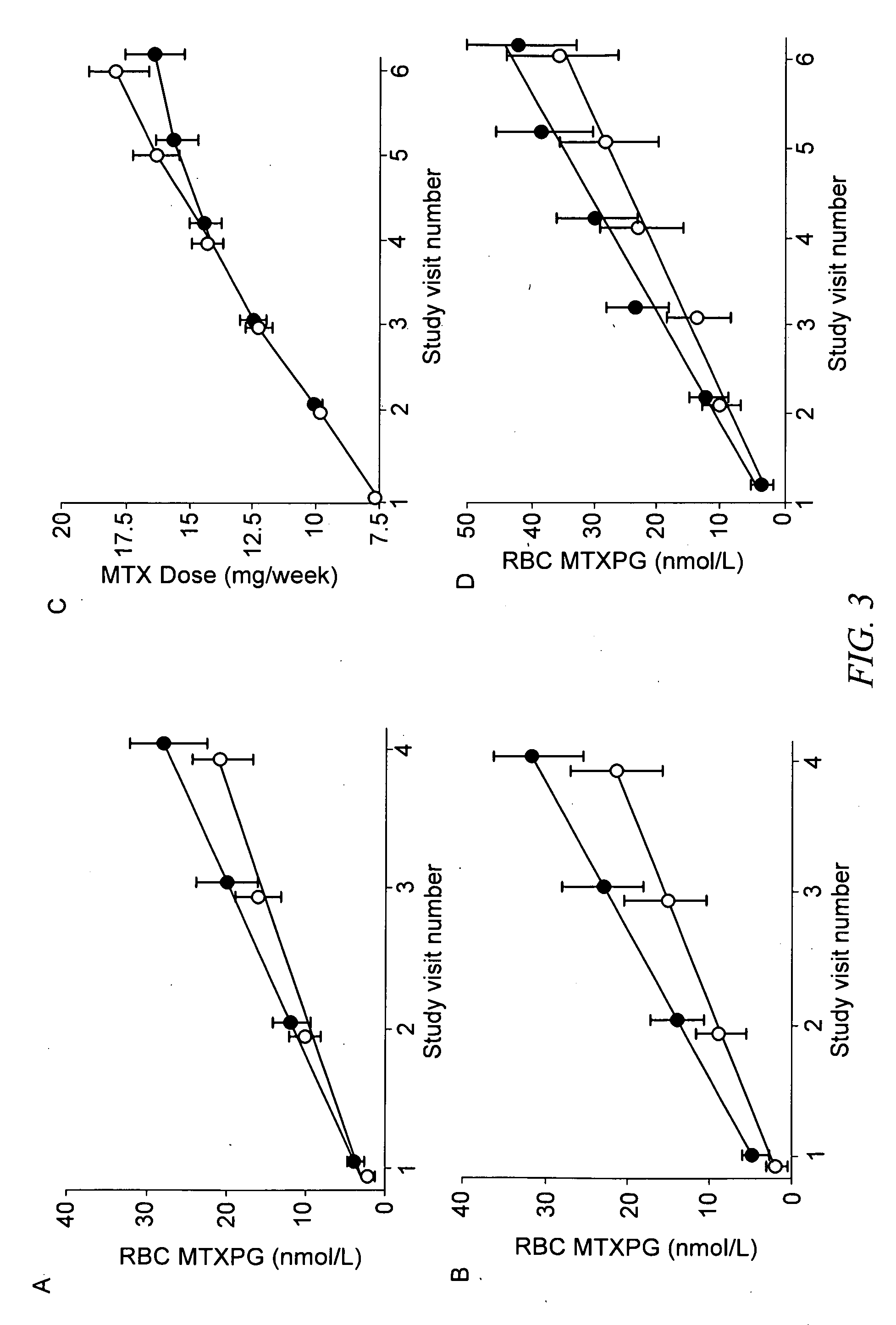Methods of predicting methotrexate efficacy and toxicity
a technology of methotrexate and efficacy, applied in the field of methods of predicting methotrexate efficacy and toxicity, can solve the problems of troublesome inter-patient variability in clinical response, low penetration rate of polymorphism, and inability to predict side effects, etc., to achieve therapeutic efficacy and reduce toxic side effects
- Summary
- Abstract
- Description
- Claims
- Application Information
AI Technical Summary
Benefits of technology
Problems solved by technology
Method used
Image
Examples
example 1
A Toxicogenetic Index for Evaluating Risk Associated with MTX Therapy
[0235]This example presents a study showing the contribution of wild-type, heterozygous, or homozygous genotypes in folate pathway genes to MTX toxicity in patients with rheumatoid arthritis. In particular, low penetrance risk genotypes in MTHFR, ATIC, TS, and SHMT1 were identified and used to generate a toxicogenetic index indicative of the risk or occurrence of side-effects associated with MTX therapy.
Summary
[0236]Methotrexate (MTX) is an anti-folate compound with significant toxicity. In this example, an association between certain genotypes in folate pathway genes and the occurrence of side-effects to MTX in patients with rheumatoid arthritis was identified. The study was cross-sectional with all patients on MTX therapy for at least one month prior to enrollment. Blood was collected and side-effects occurring at the time of a single study visit were recorded. Low penetrance risk genotypes in 5,10-methylenetetra...
example 2
Pharmacogenomic and Metabolic Biomarkers in the Folate Pathway are Associated with MTX Effects During a Dose Escalation in Rheumatoid Arthritis
[0255]This example presents a study showing the contribution of pharmacogenomic and metabolic biomarkers to methotrexate (MTX) efficacy and toxicity in patients with early rheumatoid arthritis who have not been previously treated with this anti-folate. In particular, common polymorphisms in folate pathway genes were identified as contributing to MTX efficacy and / or toxicity. As described herein, wild-type, heterozygous, or homozygous genotypes in these genes can be determined and cumulated in a pharmacogenomic index to predict MTX therapy, e.g., to evaluate the risk of developing MTX toxicity and / or to evaluate the likelihood of response to MTX. Erythrocyte methotrexate and / or folate polyglutamate levels can also be used to predict a patient's response to MTX.
Summary
[0256]In this example, 48 adult patients naïve to MTX were enrolled in a pros...
PUM
| Property | Measurement | Unit |
|---|---|---|
| wavelength | aaaaa | aaaaa |
| wavelength | aaaaa | aaaaa |
| emission wavelength | aaaaa | aaaaa |
Abstract
Description
Claims
Application Information
 Login to View More
Login to View More - R&D
- Intellectual Property
- Life Sciences
- Materials
- Tech Scout
- Unparalleled Data Quality
- Higher Quality Content
- 60% Fewer Hallucinations
Browse by: Latest US Patents, China's latest patents, Technical Efficacy Thesaurus, Application Domain, Technology Topic, Popular Technical Reports.
© 2025 PatSnap. All rights reserved.Legal|Privacy policy|Modern Slavery Act Transparency Statement|Sitemap|About US| Contact US: help@patsnap.com



